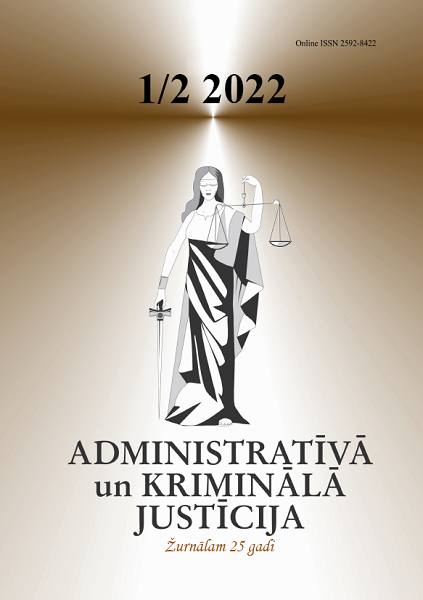USING LEGAL ENTITY IDENTIFIER (LEI) ON BLOCKCHAIN FOR REDUCING MONEY LAUNDERING RISKS AT FINANCIAL INSTITUTIONS
DOI:
https://doi.org/10.17770/acj.v1i93.6733Keywords:
LEI, blockchain, anti-money laundering, risk assessment, risk managementAbstract
The increasing use of blockchain technology nowadays can play a key role in using the decentralized network as a standard database for the unified and secured registry, through which financial institutions can conduct a relevant customer due to diligence measures and business transactions by verifying organizations’ Legal Entity Identifier (LEI) codes, self-sovereign identifiers managed by the Global Legal Entity Identifier Foundation (GLEIF). With proper implementation, this solution can be applied to blockchain networks, offering the additional advantage of quality control and detailed business analysis. Thus, by giving financial institutions the benefit of interacting with legal entities that have proved their reputation and, therefore, by reducing the money laundering risk at financial institutions, blockchain technologies now could reach global standardization and acceptance by financial institutions worldwide.
Downloads
References
Association of Certified Anti-Money Laundering Specialists (ACAMS) (2019). Study Guide CAMS certification exam. P.1.
G20 Los Cabos Mexico (2012). P.7-8. G20 Leaders Declaration. https://www.fsb.org/wp-content/uploads/g20_leaders_declaration_los_cabos_2012.pdf (request date 15.12.2021.).
Financial Stability Board (FSB). (2012). A Global Legal Entity Identifier for Financial Markets. https://www.fsb.org/wp-content/uploads/r_120608.pdf (request date 15.12.2021.).
Financial Stability Board (FSB) (2019). Press Release. P.1. https://www.fsb.org/wp-content/uploads/R280519-2.pdf (request date 18.12.2021.).
Riigi Teataja (2022). Money Laundering and Terrorist Financing Prevention Act. https://www.riigiteataja.ee/en/eli/ee/517112017003/consolide/current (request date 03.01.2022.).
Basel Committee on Banking Supervision (2020). Sound management of risks related to money laundering and financing of terrorism. P.5. https://www.bis.org/bcbs/publ/d505.pdf (request date 04.01.2022.).
Finantsinspektsiooni juhendid. Krediidi- ja finantseerimisasutuste organisatsiooniline lahend ning ennetavad meetmed rahapesu ja terrorismi rahastamise tõkestamiseks. (2018). https://www.fi.ee/sites/default/files/2018-11/FI_AML_Soovituslik_juhend.pdf (request date 28.12.2021.).
Global Legal Entity Identifier Foundation (GLEIF). https://www.gleif.org/en/about-lei/introducing-the-legal-entity-identifier-lei (request date 03.01.2022.).
Global Legal Entity Identifier Foundation (GLEIF). https://www.gleif.org/en/lei-data/access-and-use-lei-data/level-1-data-who-is-who (request date 03.01.2022.).
Global Legal Entity Identifier Foundation (GLEIF). https://www.gleif.org/en/about-lei/introducing-the-legal-entity-identifier-lei (request date 03.01.2022.).
European Securities and Markets Authority (ESMA). (2018). https://www.esma.europa.eu/policy-rules/mifid-ii-and-mifir (request date 04.01.2022.).
European Securities and Markets Authority (ESMA). (2017). https://www.esma.europa.eu/sites/default/files/library/esma70-145-238_lei_briefing_note.pdf (request date 04.01.2022.).
Global Legal Entity Identifier Foundation (GLEIF). LEI in KYC: A New Future for Legal Entity Identification. https://www.gleif.org/en/lei-solutions/lei-in-kyc-a-new-future-for-legal-entity-identification (request date 04.01.2022.).
Global Legal Entity Identifier Foundation (GLEIF). (2018). Know Your Customer (KYC): The Challenges Faced by the Banking Sector When Onboarding New Client Organizations. Research Findings. https://www.gleif.org/content/3-lei-solutions/6-lei-in-kyc-a-new-future-for-legal-entity-identification/gleif-research-findings_challenges-onboarding-client-organizations-in-banking-sector_v1.0-final.pdf (request date 05.01.2022.).
Legal Entity Identifier Regulatory Oversight Committee (LEI ROC). (2018). The Global LEI System and regulatory uses of the LEI. P. 9. https://www.leiroc.org/publications/gls/roc_20180502-1.pdf (request date 08.01.2022.).
Financial Stability Board (FSB). (2019). Thematic Review on Implementation of the Legal Entity Identifier. https://www.fsb.org/wp-content/uploads/P280519-2.pdf (request date 08.01.2022.).
IBM. Basic Blockchain Security. https://www.ibm.com/topics/blockchain-security (request date 10.01.2022.).
Global Legal Entity Identifier Foundation (GLEIF). LEI in KYC: A New Future for Legal Entity Identification. https://www.gleif.org/en/lei-solutions/lei-in-kyc-a-new-future-for-legal-entity-identification (request date 04.01.2022.).
McKenna, K., Piechocki, M. (2020). Grafting Blockchains into Enterprise Businesses - The LEI and Digital Verifiable Credentials [Video]. https://www.youtube.com/watch?v=59pPG_srJmQ&t=708s (request date 12.01.2022.).
Downloads
Published
Issue
Section
License
Copyright (c) 2022 Administrative and Criminal Justice

This work is licensed under a Creative Commons Attribution 4.0 International License.


